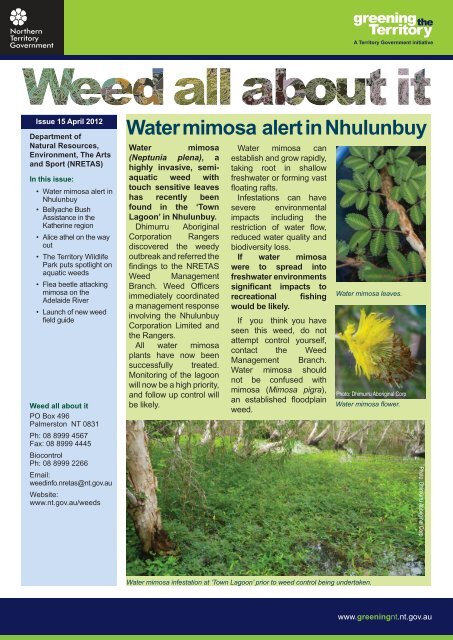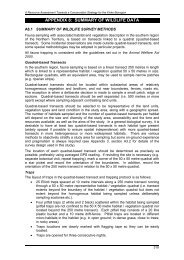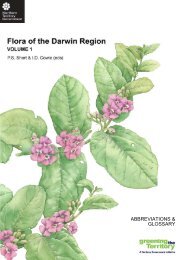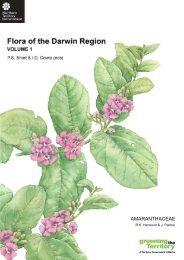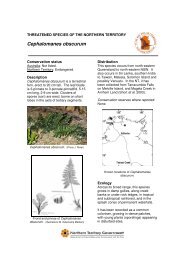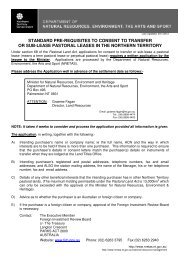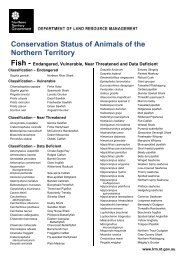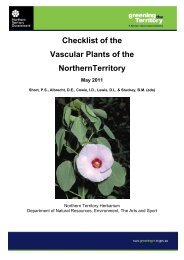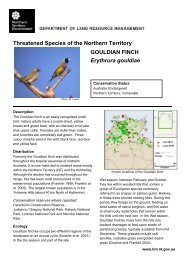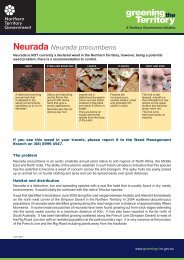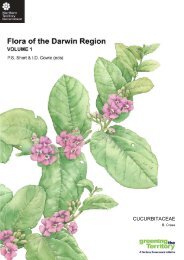Weed all about - Department of Land Resource Management
Weed all about - Department of Land Resource Management
Weed all about - Department of Land Resource Management
You also want an ePaper? Increase the reach of your titles
YUMPU automatically turns print PDFs into web optimized ePapers that Google loves.
<strong>Weed</strong> <strong>all</strong> <strong>about</strong> it<br />
Issue 15 April 2012<br />
<strong>Department</strong> <strong>of</strong><br />
Natural <strong>Resource</strong>s,<br />
Environment, The Arts<br />
and Sport (NRETAS)<br />
In this issue:<br />
• Water mimosa alert in<br />
Nhulunbuy<br />
• Bellyache Bush<br />
Assistance in the<br />
Katherine region<br />
• Alice athel on the way<br />
out<br />
• The Territory Wildlife<br />
Park puts spotlight on<br />
aquatic weeds<br />
• Flea beetle attacking<br />
mimosa on the<br />
Adelaide River<br />
• Launch <strong>of</strong> new weed<br />
fi eld guide<br />
<strong>Weed</strong> <strong>all</strong> <strong>about</strong> it<br />
PO Box 496<br />
Palmerston NT 0831<br />
Ph: 08 8999 4567<br />
Fax: 08 8999 4445<br />
Biocontrol<br />
Ph: 08 8999 2266<br />
Email:<br />
weedinfo.nretas@nt.gov.au<br />
Website:<br />
www.nt.gov.au/weeds<br />
Water mimosa alert in Nhulunbuy<br />
Water mimosa<br />
(Neptunia plena), a<br />
highly invasive, semiaquatic<br />
weed with<br />
touch sensitive leaves<br />
has recently been<br />
found in the ‘Town<br />
Lagoon’ in Nhulunbuy.<br />
Dhimurru Aboriginal<br />
Corporation Rangers<br />
discovered the weedy<br />
outbreak and referred the<br />
fi ndings to the NRETAS<br />
<strong>Weed</strong> <strong>Management</strong><br />
Branch. <strong>Weed</strong> Offi cers<br />
immediately coordinated<br />
a management response<br />
involving the Nhulunbuy<br />
Corporation Limited and<br />
the Rangers.<br />
All water mimosa<br />
plants have now been<br />
successfully treated.<br />
Monitoring <strong>of</strong> the lagoon<br />
will now be a high priority,<br />
and follow up control will<br />
be likely.<br />
Water mimosa can<br />
establish and grow rapidly,<br />
taking root in sh<strong>all</strong>ow<br />
freshwater or forming vast<br />
fl oating rafts.<br />
Infestations can have<br />
severe environmental<br />
impacts including the<br />
restriction <strong>of</strong> water fl ow,<br />
reduced water quality and<br />
biodiversity loss.<br />
If water mimosa<br />
were to spread into<br />
freshwater environments<br />
signifi cant impacts to<br />
recreational fi shing<br />
would be likely.<br />
If you think you have<br />
seen this weed, do not<br />
attempt control yourself,<br />
contact the <strong>Weed</strong><br />
<strong>Management</strong> Branch.<br />
Water mimosa should<br />
not be confused with<br />
mimosa (Mimosa pigra),<br />
an established fl oodplain<br />
weed.<br />
Water mimosa leaves.<br />
Photo: Dhimurru Aboriginal Corp<br />
Water mimosa fl ower.<br />
Water mimosa infestation at ‘Town Lagoon’ prior to weed control being undertaken.<br />
Photo: Dhimurru Aboriginal Corp<br />
www.greeningnt.nt.gov.au
Bellyache Bush Assistance<br />
in the Katherine region<br />
Bellyache bush (Jatropha gossypiifolia) is one <strong>of</strong> the<br />
most aggressive and poisonous weeds impacting<br />
the dry tropics <strong>of</strong> northern Australia.<br />
Bellyache bush forms dense thickets, excluding<br />
pasture and other vegetation. It can take over<br />
grazing land, reduce biodiversity and restrict access<br />
for mustering. The fruit and seeds <strong>of</strong> bellyache bush<br />
are also toxic to humans and animals if ingested.<br />
A strategic approach will be required to achieve<br />
effective management <strong>of</strong> bellyache bush across the<br />
Katherine region.<br />
2<br />
All land managers and owners have a responsibility<br />
to take action and manage bellyache bush on their<br />
properties. The <strong>Weed</strong> <strong>Management</strong> Branch is<br />
coordinating the provision <strong>of</strong> a range <strong>of</strong> resources,<br />
including herbicide, equipment loans and planning<br />
advice, which should enable the implementation <strong>of</strong><br />
property-scale weed managment plans.<br />
For further information contact Tahnee Thompson,<br />
Regional <strong>Weed</strong> <strong>Management</strong> Offi cer, Katherine on<br />
8973 8845.
Alice athel on the way out<br />
Control work in Alice Springs had athel pine<br />
(Tamarix aphylla), a <strong>Weed</strong> <strong>of</strong> National Signifi cance,<br />
in its sights for local eradication this year.<br />
The Alice Springs <strong>Land</strong>care Group is working in<br />
partnership with the <strong>Weed</strong> <strong>Management</strong> Branch<br />
(WMB) to remove the last <strong>of</strong> the deliberately planted<br />
athel pines from the town and surrounds to ensure<br />
that the Todd River catchment is protected from<br />
potential spread.<br />
Funded by the Territory Natural <strong>Resource</strong><br />
<strong>Management</strong> Local Grants and the Australian<br />
Government’s Community Action Grant programs,<br />
seven <strong>of</strong> the last ten sites with athel pine have been<br />
cleared by contractors and WMB staff since November<br />
2011. Cut stump, stump grinding and dozing have<br />
been used with debris burnt to prevent regrowth.<br />
The remaining three sites are targeted for cut stump<br />
treatment in April this year. These large trees, planted<br />
in the 1940s for shade, will be a ch<strong>all</strong>enge to remove<br />
without causing damage to surrounding buildings and<br />
fences.<br />
This program was established to support the<br />
Territory 2030 target to eradicate athel pine from the<br />
Territory (other than the Lower Finke River where the<br />
target is for control). Treatment <strong>of</strong> athel pine in other<br />
towns and communities has also commenced.<br />
Successfully felled.<br />
3<br />
Athel pine tree at the old Alice Springs<br />
drive-in prior to cut stump treatment.<br />
Loading the truck.
The Territory Wildlife Park puts the<br />
spotlight on aquatic weeds<br />
The Territory Wildlife Park recently displayed<br />
several invasive aquatic weeds <strong>of</strong> the Top End, as<br />
well as some native alternatives at the park.<br />
To coincide with World Wetlands Day the Park placed<br />
weeds, plants and educational resources on display<br />
for the entire month <strong>of</strong> February. The display was well<br />
received by members <strong>of</strong> the public, who were interested<br />
in learning to differentiate the weeds and native plants<br />
by viewing them at close range.<br />
<strong>Weed</strong> educational resources.<br />
The Territory Government has approved the<br />
<strong>Weed</strong> <strong>Management</strong> Plans for:<br />
• Prickly acacia (Acacia nilotica)<br />
• Mesquite (Prosopis species) and<br />
• Chinee apple (Ziziphus mauritiana)<br />
These Plans form part <strong>of</strong> a strategic approach<br />
to weed management in the Northern Territory<br />
and will provide useful information to assist land<br />
managers to control these weeds on their properties.<br />
The over<strong>all</strong> aim <strong>of</strong> the Plans is to reduce the damage<br />
caused by these thorny shrubs/trees in relation to<br />
production, environmental and cultural values.<br />
All landholders are now required to meet the<br />
management objectives outlined in the <strong>Weed</strong><br />
<strong>Management</strong> Plans.<br />
For more information or to request a copy <strong>of</strong> the<br />
Plans visit www.nt.gov.au/weeds or contact the <strong>Weed</strong><br />
<strong>Management</strong> Branch on 8999 4567.<br />
Park volunteers participated in a<br />
community involvement day on Sunday<br />
12 February assisting aquarium staff to set up a new<br />
aquatic plant nursery. <strong>Weed</strong> <strong>Management</strong> Branch staff<br />
also attended and spoke with volunteers, providing<br />
information on aquatic weed identifi cation and weed<br />
control programs currently taking place in the Top End.<br />
It is hoped that the Park’s visitors are now better<br />
equipped to report and/or manage these high priority<br />
weeds.<br />
<strong>Weed</strong>s on display included mimosa, salvinia and olive<br />
hymenachne.<br />
New <strong>Weed</strong> <strong>Management</strong> Plans<br />
4
Flea beetle attacking mimosa on the Adelaide River<br />
Thousands <strong>of</strong> beetles are taking over mimosa<br />
patches on the Adelaide River.<br />
These tiny fl ea beetles are now swarming on<br />
mimosa and will have an impact on reducing the<br />
plants ability to produce seed. Although the area<br />
currently covered by the fl ea beetle is sm<strong>all</strong>, the<br />
potential benefi t <strong>of</strong> the fl ea beetles is very exciting.<br />
The management <strong>of</strong> mimosa in the Top End<br />
has included the use <strong>of</strong> biological control since<br />
1983. The suite <strong>of</strong> insects and one rust that have<br />
established in the region have greatly reduced the<br />
output <strong>of</strong> seed and the weeds over<strong>all</strong> competitive<br />
ability.<br />
The mimosa fl ea beetle, Nesaecrepida infuscata,<br />
is the fi nal agent in the mimosa biocontrol program.<br />
Although identifi ed as a leaf feeder, the larvae <strong>of</strong><br />
this beetle will feed on seedlings and roots. The<br />
adults are long lived which enables the population<br />
to reach high numbers for long periods. As new<br />
generations develop, the stresses infl icted by fl ea<br />
beetles intensifi es. Beetles are increasingly able<br />
to feed on new leaves produced in defence by the<br />
mimosa plant.<br />
N. infuscata was fi rst released in the Northern<br />
Territory in 2007. Since then over 20 000 adults<br />
have been released. Recent fi eld surveys<br />
Close up up<strong>of</strong> <strong>of</strong> mimosa i fl flea ea beetle t<br />
5<br />
indicate that the insect is now established on the<br />
Adelaide River and showing potential to become<br />
a damaging agent. The <strong>Weed</strong> <strong>Management</strong><br />
Branch’s commitment to biological control has<br />
seen the number <strong>of</strong> insects produced in the<br />
lab greatly increase. This has been one <strong>of</strong> the<br />
contributing factors for the success <strong>of</strong> this agent<br />
in the fi eld. It is anticipated that further fl ea beetle<br />
releases will increase the chances they have <strong>of</strong><br />
surviving and increasing.<br />
Biological control aims to reduce mimosa<br />
reproduction and increase defoliation, particularly<br />
on stand edges. These impacts then enable<br />
grasses to out-compete mimosa seedlings.<br />
Biocontrol is already contributing to the<br />
integrated control <strong>of</strong> mimosa, a relationship which<br />
the fl ea beetle will hopefully strengthen.<br />
The <strong>Weed</strong> <strong>Management</strong> Branch will engage<br />
land holders and rangers alike to help them<br />
distribute this agent across the Territory later in<br />
the year. This assistance should help to speed<br />
up the spread and the impact that this tiny fl ea<br />
beetle is having on mimosa in the Top End.<br />
Leaf damage caused by the mimosa fl ea beetle.
Launch <strong>of</strong> new weed fi eld guide<br />
The new book ‘<strong>Weed</strong>s <strong>of</strong> Northern Australia:<br />
A fi eld guide’ by Nicholas Smith was recently<br />
launched by the then Lord Mayor Graeme Sawyer<br />
at the George Brown Darwin Botanic Gardens.<br />
Hot <strong>of</strong>f the press, this newly researched book<br />
by prominent weeds expert Nicholas Smith and<br />
publishers The Environment Centre NT, is an<br />
invaluable tool to help land managers identify and<br />
eradicate weeds.<br />
This book is an essential fi eld resource for seasoned<br />
land managers, those new to the issue <strong>of</strong> weed<br />
management and even gardeners wanting to know if<br />
plants growing in their garden are natives or weeds.<br />
The fi eld guide features:<br />
• Photos and descriptions for 150 weed species;<br />
• Detailed descriptions for 90 high priority species;<br />
• Species distribution maps;<br />
• Detailed botanical drawings; and<br />
• Information on identifi cation, fl owering and fruiting<br />
time, preferred habitat, dispersal mechanisms<br />
and recommended control methods.<br />
Ben Stuckey, Nicholas Smith and Piers Barrow at the book launch.<br />
6<br />
<strong>Weed</strong> information was provided by the NT, QLD<br />
and WA Governments, including weed management<br />
branches and Herbariums, the <strong>Department</strong> <strong>of</strong><br />
Agriculture, Fisheries and Forestry’s Northern<br />
Australia Quarantine Strategy, pastoralists, land<br />
management groups and Indigenous Rangers.<br />
Copies are available for $25 each, from<br />
bookstores across Northern Australia, or for<br />
bulk orders <strong>of</strong> 10 or more, $20 each from the<br />
Environment Centre NT.<br />
Contact: Lisa Peters<br />
Environment Centre NT Offi ce Manager<br />
Ph: 08 8981 1984 or Email:admin@ecnt.org


